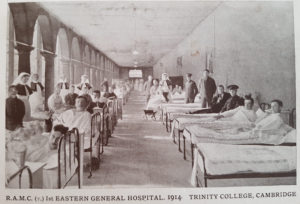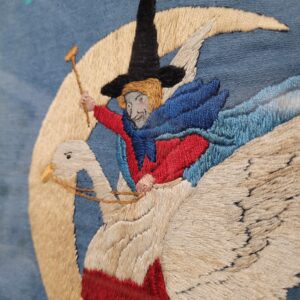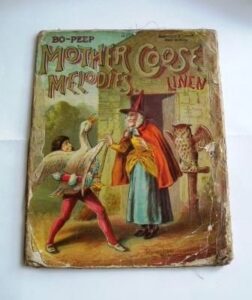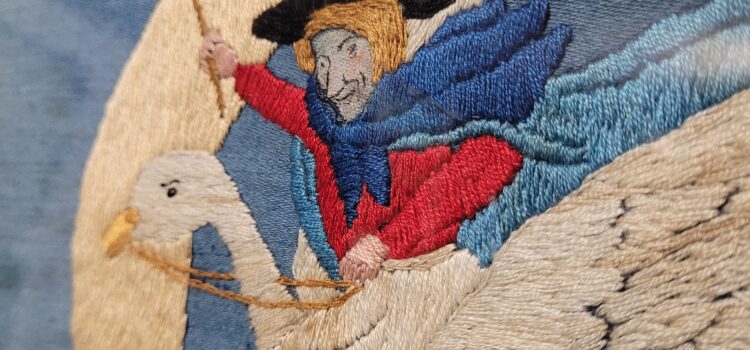‘The Stories Behind the Stitches’ exhibition is running until Autumn 2024 at the Museum of Cambridge.
The Museum of Cambridge holds a collection of embroideries stitching a range of subjects from flora and fauna to fairy tales. What is special about these embroideries is not necessarily the subject but who they were made by. This collection was stitched by a number of recovering soldiers who were staying at the First Eastern General Hospital in Cambridge during WWI. While some of the embroideries have a surname and the ward they stayed in, others have little information about the stitcher. Many of the soldiers staying at the First Eastern General Hospital will have been brought back to England probably to be operated on and recuperate. Injuries such as head traumas, blindness, amputations and brain injuries were common. They could result in long-term injuries, disabilities, or suffering from mental health issues such as depression or shell shock, a term that originated during World War I to describe a type of post-traumatic stress disorder (PTSD) that many soldiers experienced during the war.

First Eastern General Hospital – Credit University of Cambridge
Government schemes such as the Disabled Soldiers Embroidery Industry cropped up during World War I and II to help soldiers get back into employment through learning skills such as mending and needlework. Whilst the monetary reasons behind stitching are important, learning to sew for coping mechanisms when going through life changing events that have affected your body and mind are just as significant. Embroidery was something that wounded and recovering soldiers could take part in alone or in groups, sitting in a chair or in bed. It would have been common that you were staying in hospital in a city that was not your own so family or loved ones couldn’t visit, and you didn’t know any of the other soldiers, so having activities that introduced you to the people who were also going through similar physical and mental things to you helped soldiers to feel more at ease.

First Eastern General Hospital, 1914. Museum of Cambridge
If you try and put yourself in the position of a solider who has gone through a traumatic injury which has resulted in perhaps a now lifelong disability, or something that will affect them for a long period whilst they are recuperating, piled on top of the trauma that can come with serving in the war, keeping distracted when you are in hospital with all of these things happening to you mentally and physically is of much importance. Craft in general have a long history of popularity within the disabled community. Many crafts offer a creative outlet in inclusive ways and give the opportunity to develop fine motor skills, cognitive abilities, and a space for mindful activity.
When I first started my role as Collections Officer at the Museum of Cambridge, the first object when I was looking around on my first day that caught my eye was the mother goose embroidery. At the time I did not know its history of being stitched by a soldier staying at the First Eastern General Hospital, I simply loved it for the embroidery and in particular the topic as an embroiderer and illustrator myself. When I was curating ‘The Stories Behind the Stitches’ exhibition, I knew that I wanted to take the mother goose embroidery off display and redisplay it in the exhibit to give context around its origins.

Mother Goose Embroidery, Museum of Cambridge
There is quite a bit of questioning around where Mother Goose came from, but most people believe it was the French author Charles Perrault who published a collection of fairy tales ‘Histories ou contes du temps passès, avec des moralitès’ in 1695. Translated in 1729 this reads ‘Histories or Tales of Past Times told by Mother Goose.’ The book centralised the mother goose figure of an older lady who rode a giant goose and was author of the fairy tales told in the book. Fairy tales such as Cinderella, Sleeping Beauty, Puss in Boots and Little Red Riding Hood are in these books as well as poems and songs.

Mother Goose Melodies Book, Museum of Cambridge
This embroidery stood out to me because there was something lovely about knowing a soldier who had previously been interacting with something quite violent was now spending time to slow down, rest, and take the time to carefully stitch this piece. Whilst we do not have the name of the solider who stitched this piece, I try to think about why the solider may have chosen this subject. Was mother goose a childhood figure he thought fondly of? Did he have a copy of the mother goose fairytales which he read to his children, and it reminded him of them? Whatever the reason, I hope the time spent on this piece whilst staying at the First Eastern General Hospital when he perhaps felt pain and anxiety brought him some peace and tranquillity.
Written by Beau Brannick, Museum of Cambridge Collections Officer.
